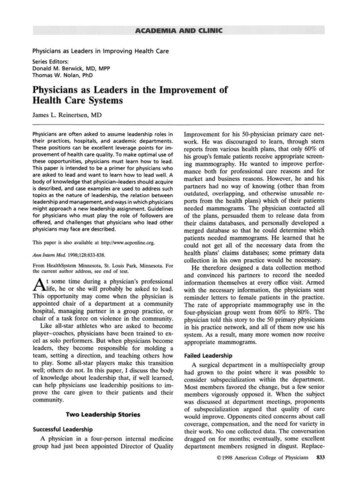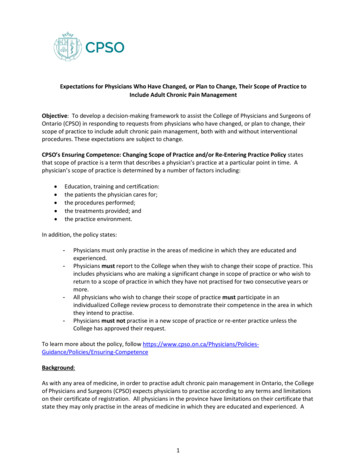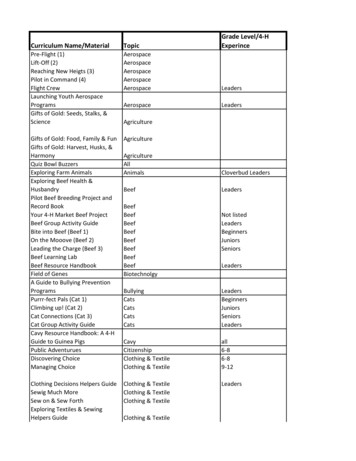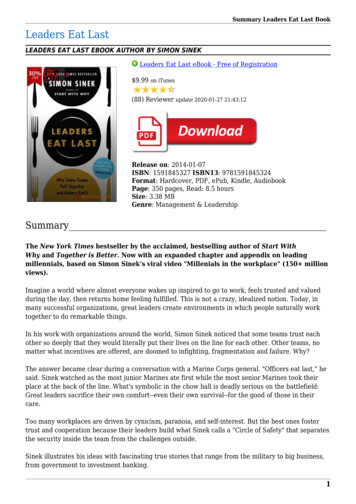
Transcription
Physicians as Leaders in Improving Health CareSeries Editors:Donald M. Berwick, MDf MPPThomas W. Nolan, PhDPhysicians as Leaders in the Improvement ofHealth Care SystemsJames L. Reinertsen, MDPhysicians are often asked to assume leadership roles intheir practices, hospitals, and academic departments.These positions can be excellent leverage points for improvement of health care quality. To make optimal use ofthese opportunities, physicians must learn how to lead.This paper is intended to be a primer for physicians whoare asked to lead and want to learn how to lead well. Abody of knowledge that physician-leaders should acquireis described, and case examples are used to address suchtopics as the nature of leadership, the relation betweenleadership and management, and ways in which physiciansmight approach a new leadership assignment. Guidelinesfor physicians who must play the role of followers areoffered, and challenges that physicians who lead otherphysicians may face are described.This paper is also available at http://www.acponline.org.Ann Intern Med. 1998;128:833-838.From HealthSystem Minnesota, St. Louis Park, Minnesota. Forthe current author address, see end of text.At some time during a physician's professionallife, he or she will probably be asked to lead.This opportunity may come when the physician isappointed chair of a department at a communityhospital, managing partner in a group practice, orchair of a task force on violence in the community.Like all-star athletes who are asked to becomeplayer-coaches, physicians have been trained to excel as solo performers. But when physicians becomeleaders, they become responsible for molding ateam, setting a direction, and teaching others howto play. Some all-star players make this transitionwell; others do not. In this paper, I discuss the bodyof knowledge about leadership that, if well learned,can help physicians use leadership positions to improve the care given to their patients and theircommunity.Two Leadership StoriesSuccessful LeadershipA physician in a four-person internal medicinegroup had just been appointed Director of QualityImprovement for his 50-physician primary care network. He was discouraged to learn, through sternreports from various health plans, that only 60% ofhis group's female patients receive appropriate screening mammography. He wanted to improve performance both for professional care reasons and formarket and business reasons. However, he and hispartners had no way of knowing (other than fromoutdated, overlapping, and otherwise unusable reports from the health plans) which of their patientsneeded mammograms. The physician contacted allof the plans, persuaded them to release data fromtheir claims databases, and personally developed amerged database so that he could determine whichpatients needed mammograms. He learned that hecould not get all of the necessary data from thehealth plans' claims databases; some primary datacollection in his own practice would be necessary.He therefore designed a data collection methodand convinced his partners to record the neededinformation themselves at every office visit. Armedwith the necessary information, the physicians sentreminder letters to female patients in the practice.The rate of appropriate mammography use in thefour-physician group went from 60% to 80%. Thephysician told this story to the 50 primary physiciansin his practice network, and all of them now use hissystem. As a result, many more women now receiveappropriate mammograms.Failed LeadershipA surgical department in a multispecialty grouphad grown to the point where it was possible toconsider subspecialization within the department.Most members favored the change, but a few seniormembers vigorously opposed it. When the subjectwas discussed at department meetings, proponentsof subspecialization argued that quality of carewould improve. Opponents cited concerns about callcoverage, compensation, and the need for variety intheir work. No one collected data. The conversationdragged on for months; eventually, some excellentdepartment members resigned in disgust. Replace 1998 American College of Physicians833
ments were recruited, but with this unresolved issuehanging over the department, some worthy candidates went elsewhere. The remaining departmentmembers were left with an increased workload, lowmorale, and uncertainty about their department'sfuture direction. The department chair never resolved the issue.Characteristics of LeadershipLeaders change things. Leaders examine the current situation, look ahead to future possibilities, andrecognize the need for improvement. They then create a new system or change the system from what itis to what it should be. Leading is therefore somewhat hazardous because it requires people to change.Leadership is an action, not a position. Having alofty title and your own parking space does notmean that you are leading. A leader initiates (1).He or she picks up the phone, calls the health plan,and asks for a disk of the practice's data on mammography.Leadership is not victimhood. To rework a Gertrude Stein line, when one arrives at leadership, onefinds that "There is no 'them' there." It would havebeen easy for the internist in the first scenario tosay, "Oh, those health plans are making my lifemiserable with all this inaccurate data, beating onme to improve mammography. It's their fault—when they clean up their data, I'll consider doingsomething." This is a common response, especiallywhen the data are questionable. It is easy to blamecircumstances or to point the finger at "them."However, one cannot simultaneously be a leaderand a victim (2).Leaders define reality (3), often with data. In thefirst scenario, the mammography information wasunusable until the leader sorted it out. It then became a powerful stimulus for improvement. Conversely, in the second scenario, the surgical department chair failed to collect any data, leaving thesurgeons with dueling opinions.Leaders develop and test changes. If a test showsthat a change is good, many other physicians willmake that change. This may be the most commonopportunity physicians have to lead because it doesnot require that the leader be in a titled leadershipposition.Leadership takes courage. Many physicians, especially in such large organizations as hospitals orgroup practices, see their role as to shoot at theskeet served up by administration. Leader-physicians run risks by proposing change (serving upskeet) to their colleagues. Physicians are skilled atcritical thinking and can find every possible reasonto reject a new idea. Leaders take that risk.Leaders persuade. In the first scenario, the health83415 May 1998 Annals of Internal Medicineplans had to be convinced to give out data in anunprecedented manner. Persuasion requires credibility, persistence, and an exceptional ability to describe the difference (in terms that are personallymeaningful to each participant) between the statusquo and the desired future state.Physician-leaders need the "mantle of leadership."What gives physicians the credibility necessary topersuade other physicians? Physician-leaders receive a mantle from their colleagues on the basis ofthe belief that they are excellent physicians and aretrustworthy, confident, articulate, and willing to admit mistakes. They have walked a mile in the shoesof their colleagues. This mantle is necessary but notsufficient for leadership. "A promotion to managercan give authority, but not power. It is the peopleyou are to manage who will give you power" (4).This mantle also has a dark side. Some physicians who vote to bestow power on a fellow physician do so with the expectation that that physicianleader will look out for their particular interests. Ifthe physician-leader takes a larger view on an issue,his or her colleagues may retract their support. Thephysician-leader must have a gift for balancing theconcerns of department members with the needs ofthe larger system. No system can function optimallyif each department works solely for its own interest.(5, 6).Leaders are not daunted by the loudest negativevoice. One dissenter can derail a worthwhile improvement in a hospital, academic department, orpractice. Leaders listen to all voices and then mustbring the group to action despite heavy criticismfrom within the group itself. Votes are useful, but ifa few persons vote against an improvement, it doesnot mean that the improvement should come to ahalt (7).Leaders must do much of their work outside oftheir immediate area of responsibility. The first scenario crossed the boundaries of private practice, thehealth plans' data sets, and a primary care network.Most useful improvements require a leader who isable to think and work "outside the box." (8). Thisadds complexity to the leader's work but dramatically increases the likelihood of meaningful improvement (5).Leading and Managing: Some DefinitionsA useful definition of leadership is (9). . . a set of processes that creates organizations in thefirst place or adapts them to significantly changingcircumstances. Leadership defines what the futureshould look like, aligns people with that vision, andinspires them to make it happen despite the obstacles.Leadership is focused on producing needed change.Management, on the other hand, might be de- Volume 128 Number 10
fined as "working with people and processes to produce predictable results." This paper is too brief toallow a full exposition of the interesting interactionsbetween these two concepts. One is not superior tothe other, and we need physicians who can bothlead and manage.It is also naive to suggest that every physicianwho is asked by his colleagues to lead is automatically qualified to produce either needed change orpredictable results. Receiving the mantle does notconfer the ability to lead a team meeting, map acare process, or develop and manage a budget.These and many other high-level skills must belearned if physicians are to be effective in improvingquality of care for their patients.What a Physician Should Do WhenAsked To LeadSuppose that you have just accepted the responsibility to be the leader of your six-physician officepractice. You have observed some physician-leadersin the past. You believe that leadership is necessaryand that good leadership can be a force for improvement. What should you do as you begin sucha role?Step back and take a look your system "from thebalcony." Pretend that you can view your medicalgroup from a balcony. As you gaze down, ask yourself: Whom do you serve? What is the main thingyou do for those you serve? How does the serviceyou provide come across to patients and other customers? Are the nurses, physicians, receptionists,and administrators all pointed in the same direction,or are they working toward different aims? For example, is the administrator trying to minimize laborcost per hour; the receptionist trying to get as manypatients as possible into physicians' schedules; thenurse trying to improve documentation of preventive care; and the physician trying to give the bestpossible care to each patient, with priority for thesickest ones? How do these priorities interrelate?Do you see friction and conflict at the interfacesbetween these persons and their work processes?How does your office practice fit into the largersystem of care plans and care providers? The community health system? As a leader, your first job isto take the view from the balcony.Get to know your customers. There is no substitute for listening to your customers. Your ultimatecustomers are not physicians, hospital administrators, the government, or health plans. They arethose who use and pay for your services—patients,employers, and taxpayers. Make it a habit to go tothem, bring them to your department meetings, andhear what they have to say to get as accurate apicture as possible of how they see your services.You must bring this reality to your team, and youcannot bring it if you do not know it.A physician's primary responsibility is the wellbeing of the patient; therefore, physicians are goodleaders for health systems only if they have a deepunderstanding of the nature of the physician-patientrelationship. The best physician-leaders always behave as if they have a patient at their elbow, andthey bring the patient's perspective into every conversation. To do this well, leaders must spend timein real conversation with patients and must gatheruseful data about system performance as seen bypatients and in relation to the root needs of patients. A good leader is then able to translate patients' reality into words, pictures, graphs, and othervehicles in such a way that all members of the teamshare the same reality—the customers' reality.Ultimately, your knowledge of what patientsneed will ensure that you work on aspects of carethat they will notice. Change for the better is hardwork and takes a lot of organizational energy. As aleader, you must see that your clinic uses its limitedcapacity for change on improvements that reallymatter.Establish alignment toward a shared aim. Yournext task is to begin a series of conversations withteam members. The eventual purpose of these conversations is to bring everyone on the team to ashared understanding of the aim of the office practice and how each person's work fits into that aim.The agreement on aim is important becausealignment is not expressed in words as much as it isexpressed in actions and policies. The physiciancompensation system, the billing and coding system,the receptionist training and scheduling system, andthe office nurse performance evaluation process areall interdependent in some way. Do these systemssupport each other? Are they dissonant? When youstart to critically examine compensation, scheduling,and performance evaluation, words like "aims" and"mission statements" stop being fuzzy and start getting close to where people live.Your job as a leader will be more enjoyable ifyour team, its incentives, and its policies are allaligned toward a common aim. Similarly, most of aleader's painful problems can be traced to the lackof alignment of these elements. You do not have tofeel responsible for articulating the aim personally,but you do need to work with other leaders andwith your team members to see that an aim isarticulated; that everyone understands it; and thatyou are steadfast in your resolve to align all persons, policies, and procedures towards that aim. Theprocesses by which the common purpose becomesunderstood and shared and the processes by whicheach person in your department or clinic comes to15 May 1998 Annals of Internal Medicine Volume 128 Number 10835
know his or her role in accomplishing that purposeand gets to feel personal fulfillment are central tothe work of a leader. This job will continue for aslong as you are a leader. It is never done.Become process-literate. As the leader, you mustknow the general processes that your office is using—from the low-power "balcony" view, atleast—so that you can credibly work to optimize theperformance of the system. You must be "operationally aware." You cannot know your people, thework they do, or the customers you serve if you sitbehind your desk. By being frequently present inthe midst of your team's work, you gain a real senseof what is wrong and what is possible. You also gainreal credibility and show your team that you careabout them and their work (10).It is not enough to simply wander around yourclinic. As you wander, you should ask several keyquestions about the work processes, such as:1. How is this process performing? (To make thisless abstract, substitute for "this process" suchwords and phrases as "scheduling," "making a referral," "retrieving a medical record," "radiology reporting," or "patient billing.")2. Does it give you joy to work in this process?3. How well will this process perform the nexttime it is used? This important question involvesprediction, which requires that you obtain some dataabout how the process performs over time (11, 12).4. What would this process look like if it wereworking perfectly?Balance playing and coaching. You may havebeen appointed to this leadership role because it isapparent to others that you are a good problemsolver. That does not mean that you should nowsolve other people's problems for them.Remember, you are like the former all-starplayer who is now the player-coach. Your main jobis to coach, which means that you will not get toplay as often as you might like, even if you are surethat you could do a better job than the players outon the floor. You cannot provide leadership in theform of solutions (13) You must enable the peoplein your office practice to see the problems and findsolutions, because as soon as one improvement ismade, there will be a new problem to solve. If yourstaff cannot continually improve their work—if yourorganization cannot adapt and learn rapidly—youwill have to do all of the work yourself (14)Drive out fear. If you are to lead your colleagues,you must know the truth about the performance ofthe group. You cannot learn the truth in an environment of fear or intimidation. If nurses fear physicians and are therefore reluctant to speak up, youwill be less effective at making improvements. Ifyour colleagues fear retribution, loss of income, orloss of prestige because of lack of confidentiality in836data collection, you will get distorted data and otherversions of game-playing. In fact, whenever data areloaded down with the attached baggage of rewardor punishment, data distortion occurs. As a newleader, you must make it clear to your staff that youare interested in learning the truth, even if it hurts,and that you are not looking for someone to blamefor problems. To do this, you must design compensation, performance feedback, and other policiesthat minimize the likelihood that your team members will be tempted to distort the data you needfor improvement.Physicians fear most that they will be blamed fora bad result of a patient's care. If quality is not whatit should be, one of your roles as a leader is toavoid the search for bad apples; rather, focus onimproving the processes and systems in which yourphysicians work. For example, when an orthopedicdepartment leader learned that one of his colleagues had just had two consecutive cases of postarthroscopy infections, his first response was not toinvestigate his colleague. Instead, he analyzed therecord of similar infections over the past year andnoted that many orthopedists had had a case or twoof infection. In each instance, the infections occurred in a patient whose arthroscopy had beenscheduled toward the end of a busy day. Furtherinvestigation showed that the procedure for quicksterilization of the arthroscope (necessary for reusing an arthroscope that had previously been usedthat same day) was defective. The sterilization procedure was changed, and the infection rate droppedto 0%. The problem was not a bad apple, it was abad process.Occasionally, after the process has been improved, some persons continue to perform badly. Atthat point, the leader must take a different kind ofaction to improve quality. However, when qualityproblems surface, it is far more common to findthat each individual physician is working diligentlybut in a defective system.Improve yourself. The only part of the system thatyou really control is your own investment in improvement. You cannot be an effective leader forimprovement if you do not spend time and effort onimproving your own work. Read, attend seminars,view tapes, and speak with others who might mentor you. One of the best ways to learn is simply toobserve good leaders. Detach yourself from the content of the situation and notice the leadership process. What is the leader doing to establish alignment, to get people to share a common picture ofthe future possibilities, and to effect change?Speak from the heart. When you have somethingto say, be direct and honest and willing to showyour emotions. People will grow to trust you if theybelieve that you really mean what you say. Leader-15 May 1998 Annals of Internal Medicine Volume 128 Number 10
ship is about more than data and logic, and anoffice meeting is not a National Academy of Sciences conference. If people know that you arespeaking from the heart, they will give you morecredit than you would expect, even if they disagreewith you. However, this principle flows both ways:You must also create an environment in which it issafe for everyone to speak from the heart.Leading and FollowingIncreasingly, physicians work in settings that arevery different from the traditional setting of the solopractitioner. Almost every physician in the UnitedStates has a hospital department chair, a hospitalmedical director, a chief administrator, a presidentof the medical group, or another leader to whom heor she must relate. Leaders exist only in relation tothe people whom they lead. If there are leaders,there must also be followers, and following is not anatural act for proud, independent professionals,such as physicians. Knowing how to relate to leadersrequires as much learning as knowing how andwhen to lead. Although this paper focuses on therole of physician leadership in improvement of caresystems, it would be remiss if it did not address animportant role for physicians—follower, team member, or participant. Some suggestions follow for howphysicians might relate to department chairs, hospital chief executive officers, or other leaders.Participate. Leaders really want and need yourideas, criticism, and opinions. In general, organizations are run by those who show up and stay untilthe vote is taken. Do not stay home while an issueis being discussed at your department meetings andthen attack the program or change effort when itbegins to unfold. Take the time to participate in theprocesses organized by your leaders.Be candid. Tell leaders what you really think. Itdoes no good to show up if you do not speak yourmind. This is not usually a problem for physicians,except that they sometimes choose to speak their mindin the parking lot after the meeting, not during it.Maintain a positive outlook. The best team members can analyze problems, contribute to solutions,and participate in testing improvements while maintaining a positive attitude about the potential of theteam to address the problems. It is important to beappropriately skeptical about unsubstantiated opinions. At the same time, no one wants to be on ateam with a chronic pessimist.Be respectful. When you do speak up in a meeting, remember that it is possible to attack an ideawithout attacking the person who voiced the idea.Be responsible. Do not expect leaders to protectyou from reality and solve all of your problems foryou. Leaders often get to be leaders because theyhave proven themselves to be good problem-solvers.You cannot expect your leaders to come up with allof the answers. It is not enough to offer your criticisms about an issue; you must help to discover thesolutions.Be a team player. If a leader is to lead, he or shemust often choose between competing ideas orstrategies. Just because the decision did not go yourway does not mean that your ideas were not takeninto account or that no one listened to you. Healthcare organizations are often paralyzed by the fear ofoffending one loud negative voice, usually that of aphysician. Speak your piece and participate in theprocess. If yours is clearly a minority view, work toadapt yourself to the eventual decision.If your view did not prevail and the data showthat the rest of the team was probably right, acceptit and get on with your work. Undermining theteam after the data are analyzed indicates that youprobably do not share a common goal with the restof your team. If you are chronically out of synchwith your team, you may need to change teams.Special Challenges Encountered byPhysician-LeadersThe leadership issues described above are notnecessarily unique to health care. But some professional organizations, such as academic departmentsof medicine, multispecialty groups, and independentpractice associations, have special features that deserve mention, especially with regard to quality improvement.Cherishing of Custom-Crafted VariationPhysicians are skilled craftspersons who areproud of their ability to custom design the care ofeach patient. In a peculiar way, they can be resistantto making their work easier or more error-proof ifdoing so threatens this craftsman role.Black Hat ThinkingPhysicians are also good critical thinkers and usethese skills in their daily practice. When an idea forchange surfaces, they are adept at what De Bonocalls "black hat thinking," a thinking style that emphasizes judgment and caution. This style is useful,but it will stifle innovation and change if it dominates every meeting (15).Tension between Administrators and PhysiciansRather than seeing physician-leaders as partners,some hospital and clinic administrators harbor fearand resentment toward these "amateur administrators." Similarly, physicians often characterize professional administrators as the main obstacle to be15 May 1998 Annals of Internal Medicine Volume 128 Number 10837
overcome. This tension can sabotage real improvement because almost all improvements require cooperation between administrators and clinicians.Physicians and administrators alike must respectand trust each other if true improvement is to flourish.The Compartment versus the WholeOften, as noted above, the hardest challenge fora physician-leader is to know whether to look outfor those who asked him or her to lead or for thebroader interest of the whole system. If the physician-leader represents a department, he or shemight end up shielding department members fromneeded changes. If, on the other hand, the physician-leader takes the system view, he or she may beperceived by the department as having sold out toadministration. The best guide through this problemis for the physician-leader to remember that, as aphysician, he or she must ultimately answer to patients and must do what is in their best interest,regardless of which persons inside the system takeoffense.ical factions that waste energy; and absence of timefor organized reflection, which inhibits learning.Physician leadership roles are powerful potential leverage points for improvement of the health caresystem. As citizens in the health care system, physicians have an obligation to learn as much as possible about effective leadership so that when anopportunity to lead comes, they will make optimaluse of it.Key Points To RememberLeaders must embody the values of those w h o m they leadLeaders make needed changes, and managers make processes more reliableand predictable; both roles are importantLeadership is an action, not a positionLeaders define the reality of the customer for those w h o m they lead, andthey often use data to do soLeaders work on the system and at the boundaries of the system; thosew h o m they lead work in the systemThe central work of leaders is to define the aim of the system and t o alignall persons and processes toward that aimLeaders do not necessarily have to make the improvements and changesthemselves, but they do need to establish an environment in whichimprovement can thriveMost leadership skills are not innate traits; rather, they can be learned.When physicians learn and practice them, they can substantially improvehealth careLeadership and PowerLeaders must occasionally use power. Doing socauses great discomfort for all physician-leaders,especially in circumstances where the leader mustdiscipline or even dismiss a fellow physician. Physicians hesitate to violate the professional autonomyof colleagues. In such situations, it is important toremember that nothing destroys morale and qualityfaster than persistent tolerance of incompetence,flaunting of stated values, or active undermining ofthe work of the team. Even though it is painful todo it, leaders must use power in such circumstancesor quality will suffer.Acknowledgments: The author thanks physician and administratorcolleagues in Park Nicollet Clinic and HealthSystem Minnesotawho, for 19 years, have allowed him to learn about leadership intheir midst.Requests for Reprints: James L. Reinertsen, MD, HealthSystemMinnesota, 6500 Excelsior Boulevard, St. Louis Park, MN 55426.Current Author Addresses: Dr. Reinertsen: HealthSystem Minnesota, 6500 Excelsior Boulevard, St. Louis Park, MN 55426.Dr. Berwick (Series Editor): Institute for Healthcare Improvement, 135 Francis Street, Boston, MA 02215.Dr. Nolan (Series Editor): Associates in Process Improvement,1110 Bonifant Street, Suite 420, Silver Spring, MD 20910.ReferencesConclusionsAmong the many roles physicians play is the roleof leader. When physicians assume leadership, theymust not only learn the specific methods and toolsthat will allow them to measure, understand andimprove care but must also acquire the skills andabilities that will allow them to lead departments,office practices, and complex health care institutions. This body of knowledge permits physicians towork as leaders on a system of care, not just in it.When physicians work on a system, they acceptthat their main purpose as leaders is not to fixquality problems and make quality improvements.Rather, their main purpose is to establish an environment in which quality improvements can thrive.Therefore, the main work of the physician-leader isto remove environmental hazards to quality, such asdata policies that promote fear; compensationmethods that inhibit collaboration; unaligned polit83815 May 1998 Annals of Internal Medicine1. Clemmer J. Pathways to Performance: A Guide to Transforming Yourself,Your Team, and Your Organization. Rocklin, CA: Prima; 1995:19-32.2. Connors Rf Smith T, Hickman C. The Oz Principle: Getting Results throughIndividual and Organizational Accountability. Englewood Cliffs, NJ: PrenticeHall; 1994:25-56.3. DeP
Physicians are often asked to assume leadership roles in their practices, hospitals, and academic departments. These positions can be excellent leverage points for im provement of health care quality. To make optimal use of these opportunities, physicians must lear leadn ho. w to This paper is intended to be a primer for physicians who










